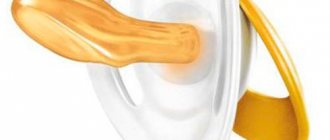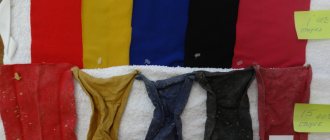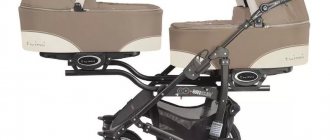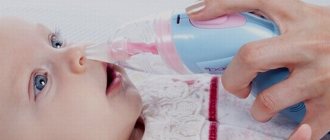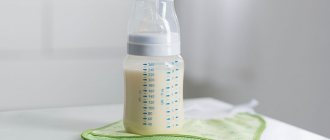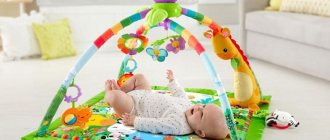How to choose a bottle and pacifier for feeding your baby? Find out about the quality of nipples, types of bottles and get help in choosing
Sooner or later, every mother is faced with the need to choose a bottle and pacifier for feeding her baby, even if he is completely breastfed. By six months, almost all children become familiar with the bottle, because new “drinks” begin to appear in their diet - for example, fruit juices; we recommend consulting with your pediatrician regarding the volume of complementary feeding.
Choosing a bottle and pacifier for your baby is a responsible task, because the baby’s well-being depends on their quality and whether they are comfortable for the child. And if we are talking about a mixed-fed baby, then the quality of the nipple determines how successfully you can combine breastfeeding with supplemental feeding with infant formula. How to make the right choice?
It all depends on the situation: on the nature of feeding and the choice of formula for feeding which the nipple and bottle will be used. Let's take a closer look at the existing models of bottles and nipples, as well as the situations for which they are intended.
Is a pacifier really necessary for a newborn?
The pacifier is one of the most controversial baby items. Some are categorically against pacifiers, while others, on the contrary, cannot imagine life without such a device.
Everyone is in favor
First of all, you need to understand that the main reflex in newborns and children in the first months of life is sucking. He needs to be satisfied.
The act of sucking stimulates the development of the digestive and nervous systems, in particular the brain.
Breastfed children often do not take and refuse the pacifier. This fact is due to the fact that infants satisfy the sucking reflex with the help of the mother's breast. Natural feeding is organized at the request of the child. Therefore, a mother can easily understand when the baby is hungry or needs “communication” with his mother. But even while breastfeeding, you may need a pacifier.
There are situations when a mother cannot breastfeed right away, then a pacifier can distract the child and satisfy the sucking reflex. Also, in some circumstances, for example, in a clinic during various medical procedures, it is necessary to calm the child, then baby pacifiers are indispensable helpers.
On the street, children often wake up and start crying, and to prevent the child from swallowing cold air, the mother can give a pacifier. This accessory provides the baby with psychological comfort and allows him to feel calm.
Children who are bottle-fed almost always need to satisfy their sucking reflex. Because bottle feeding is carried out at regular intervals at certain hours. The on-demand principle does not apply to “artificial” babies. Therefore, a pacifier is recommended for use for such children.
Facts against pacifiers
Most dentists claim that pacifier abuse leads to the development of an incorrect (open) bite. This pathology develops in those children who are constantly offered a pacifier, regardless of the circumstances. Usually such children are very excitable. And to calm such a child, parents are forced to use a pacifier.
As the child grows and develops, one can observe disturbances in diction and articulation in children who abused this accessory in infancy.
Some studies have shown that chronic pacifier sucking increases the risk of developing ear infections. Because this process increases the pressure in the auditory tube, and the likelihood of infection increases sharply. Often a child demands the mother's attention when he cries. But parents may misinterpret this situation and offer a pacifier, thereby the baby cannot satisfy his needs for “communication.”
Many experts recommend weaning your baby off the pacifier after 6 months. Because the baby becomes independent and is able to pick up the pacifier from the floor if it falls. As a result, the problem of sterility arises for parents. The mother may simply not have time to monitor the baby, who constantly takes out or drops the pacifier. Such children may develop various intestinal infectious diseases.
The problem of weaning arises most acutely for those parents who put their child to sleep every day with the help of a pacifier. Such children become very attached to it and cannot imagine a peaceful sleep without a pacifier.
Pacifier and breastfeeding
Mothers who are breastfeeding need to be careful with the pacifier.
Do not offer a pacifier to a baby before breastfeeding.
The technique for sucking a pacifier and sucking a breast is significantly different. During feeding, the baby needs to open his mouth wide and grasp not only the nipple, but also the areola. The mother's nipple must be on the root of the baby's tongue to ensure effective sucking. When using a pacifier, your baby does not need to perform the above steps. Consequently, the baby may not latch on to the breast due to difficulty sucking. Ineffective feeding contributes to stagnation of milk in the mother's breast, insufficient weight gain of the child, and a decrease in the amount of milk.
Mom's doubts: will the baby be able to do without a mother substitute?
Mothers often have doubts about whether or not to give their newborn a pacifier. The following questions cause concern among women:
- Open mouth while walking in frosty air. The situation can be corrected by raising the baby's head. Modern strollers are equipped with this function. You can also use a thin newborn pillow or a folded diaper.
- Strong attachment to the child. Women prefer to give a pacifier to teach them to fall asleep without breastfeeding. But mother's milk contains substances that soothe and help you sleep. It is much easier and more comfortable for a baby to fall asleep with a breast than with a pacifier.
- The baby pushes away from the breast and protests, but takes the pacifier with pleasure. This sign indicates the beginning of the refusal of breastfeeding. If a woman has set herself the goal of transferring her baby to IV, then she is on the right track.
- Going to work requires the use of a mother substitute. Most often, women decide to continue their careers after the baby is six months old. At this age, the child is already able to remain without breastfeeding for up to 6 hours, receiving other food. Therefore, there is no need to accustom him to a pacifier.
- Harm from prolonged feedings and frequent regurgitation. Often women believe that the baby is spitting up from overeating. To avoid this, mothers offer a pacifier. But a little spitting up is normal. The causes of pathological regurgitation are improper attachment, an immature nervous system, or gastrointestinal diseases.
We recommend reading: What is tubing for skating, how is it different from a cheesecake?
How to choose the right pacifier?
A pacifier is the simplest item among baby supplies. But even when purchasing such a product, you need to be careful and pay attention to some features.
Optimal pacifier shape
The optimal pacifier shape is the one that follows the contours of the mother's breast nipple. Thanks to this, the baby will not only feel psychological comfort, but will also not refuse the mother’s breast. The most popular shape is the classic round.
This form is most familiar to the generation of past years. This nipple model truly follows the shape of the mother's nipple. The pacifier is round and has a narrowing at the limiter. The main disadvantage of such a pacifier is the formation of an incorrect (open) bite .
Currently, new modern models are being created that solve the problem of changing the facial skeleton. This model includes an anatomical pacifier . The nipple has a smoother shape and becomes thinner towards the stopper. An anatomical pacifier is also called teardrop-shaped. This model completely replicates the baby’s oral cavity.
The most well thought out is the orthodontic form of the pacifier . This pacifier minimizes the development of malocclusion. It is flatter than the previous ones, and also has a beveled nipple. An orthodontic pacifier is also an anatomical option and is recommended for use by dentists.
Size
The size of the pacifier should be selected taking into account the age and individual characteristics of the child. The smallest models are created for premature and weakened children. Newborn nipples are smaller in size for greater comfort during use.
Different representatives of pacifiers have their own size chart. But the most common size variation is age-appropriate models. The smallest nipples can be used up to 6 months, the middle category is designed for babies from 6 to 12 or 18 months. And the largest ones can be offered to a child over 18 months. Some brands provide smaller age ranges.
Material
Material may vary. The most budget-friendly are latex models. This material is not recommended for use because it is not dense and elastic enough. As a result, the child may refuse the breast after such a nipple. Latex also has an unpleasant odor and a specific taste.
Modern pacifier models are made from safe silicone. It is transparent, odorless and tasteless. And also the main advantage is its density and elasticity, thanks to which the baby is less likely to refuse the mother’s breast. An important fact is that silicone is more difficult to chew than latex.
Appearance of the pacifier
When choosing a pacifier, you should also pay attention to the stopper itself (the part of the pacifier that is located directly on the baby’s face). It must have a special cutout for the nose. Such a recess can also be symmetrical, for greater convenience during sucking. It is also necessary to have holes so that the baby can breathe calmly. On the modern market you can see various variations of nipples - with a built-in thermometer or a dispenser for administering medications during illness.
Auxiliary accessories
Along with the pacifier, the manufacturer offers a large number of different accessories.
It is better to give preference to pacifiers that include a protective hygienic cap.
If there is no cap, you can find a special container where you can store a clean, treated pacifier. To prevent the baby from losing or throwing the pacifier on the floor, devices have been created that are attached with one side to the baby’s clothes and the other to the pacifier. Thereby keeping the pacifier on the baby’s clothes. But this accessory does not protect against pathogenic microorganisms.
Varieties
The sucking part of the pacifier has 3 varieties:
- Classic in the shape of a drop
. It is convenient in that it can be given from any side and twisting the pacifier in the mouth will not be externally or tactilely noticeable - the protective disk of these is usually round. The disadvantage of the classic drop is the risk of malocclusion due to the lack of need for muscle tension when sucking. - Anatomical pacifier
elongated with a flat or beveled tip. When it is placed in the mouth, the tongue takes a natural position, so nothing interferes with the baby, sucking movements activate the necessary groups of maxillofacial muscles. - Orthodontic is recognized
by dentists and pediatricians as the most “correct”. It is similar to the anatomical one, but has a more ergonomic shape; when sucking, all the key muscles of the mouth and jaw are activated, and a correct bite is formed. The shape of the pacifier can be flat, beveled or voluminous “cherry”; the type is selected taking into account the size of the child’s mouth and palate.
In addition to the shape, the differences also lie in the material used to make the pacifier:
- Latex
has been used for manufacturing for decades, it is soft, it is suitable for weakened and premature babies - it is closest in tactile properties to the skin and mother's breast. In rare cases, there is a risk of allergies due to the presence of protein in the rubber; the service life of latex pacifiers is limited to one month due to the structural change of the material upon contact with saliva. - Silicone
is absolutely safe, it does not cause allergies, pacifiers can be treated with boiling water. Its difference from rubber is that it has a more rigid structure, so sucking a pacifier is more difficult, and the child will need more effort to do this. When teething, it is better to avoid silicone - just bite through it, and you should change the pacifier at least once every 5-6 weeks.
The choice of a pacifier for babies is not limited to the rationalism of parents; it is mainly a process of trying out different models: there will be no interest in some at all, while others will be accepted with a bang. Experts from the EXPERTOLOGY portal found out which products babies prefer and compiled a rating of the 11 best pacifiers. The opinions of parents, dentists, and pediatricians were not ignored.
Where should you buy pacifiers?
Today, finding a pacifier is not a problem. The important point remains that the product must be certified. Modern manufacturers undergo product testing and have quality certificates.
Specialty stores
Every year, more and more specialized children's stores are being created, even in small towns. There you can find a large selection of children's products from various foreign manufacturers. Also, a pacifier can be found at any nearby pharmacy.
Online stores
Online shopping is very convenient, and many parents switch to shopping on this site. You can select and order products without leaving your home. This fact is an undeniable advantage for parents who have a small child. Online stores can be from large specialized children's hypermarkets, as well as from various foreign brands that provide this or that product.
Basic selection rules
Before deciding on the material, you need to consider other factors:
- Baby's age.
- Pacifier size.
- Mouthpiece shape.
A size A pacifier is suitable for a baby 0-6 months old, a size B for a baby 6-18 months, and a size C for an older child.
Advice. Pediatricians recommend buying pacifiers in strict accordance with age. A pacifier that is too large fills the baby’s mouth, and a small one causes stronger compression of the gums. These factors can lead to subsequent malocclusion.
The mouthpiece (rim) must have holes for the child to breathe freely. They also serve as grooves for the drainage of saliva, the accumulation of which causes irritation of the delicate baby skin.
Rules for using a baby pacifier
Before using a pacifier, you must boil the item or process it in a special sterilizer. It is very important not to hang the pacifier from a string around the baby's neck, because there is a high risk of suffocation. There are various fasteners available to attach the pacifier to the baby's clothes.
It is recommended to use the pacifier as needed. After use, it is important to store it dry in a special container or under a protective cap. During the day, it is recommended to treat the pacifier with boiling water at least once a day and whenever it becomes dirty.
Mothers are strictly prohibited from licking the pacifier before giving it to the child!
It is recommended to change the pacifier if it develops cracks or other defects. It is also important to observe the service life of the pacifier, which is always indicated on the packaging. The average lifespan of latex nipples is about 3 weeks, and silicone ones - up to 5.
Recommendations for choosing pacifiers for babies
There are different types of products. Some buying tips are given below:
- The size of the nipple is selected according to the baby's height. The first size is intended for children up to six months, size 2 - from 6 months and above.
- By design, the product consists of a nipple and areolar part. The size of the first is associated with the length of the palate, the other with the height of the upper lip and the length of the mouth slit. Therefore, pacifiers are marketed for premature and full-term infants.
- The bottle-nipple design requires the presence of an air valve. It prevents the baby from swallowing air masses during feeding. The product will not slip out of your mouth.
- If you use nipples with a truncated surface on one edge, the tongue will put pressure on that part and will be positioned more widely. Subsequently, the lower jaw will begin to grow. If the side falls forward too much, it stimulates the formation of the palate and maxilla.
- When the hole is angled away from the top of the pacifier, it helps food flow properly.
Pediatrician's opinion: to give or not to give a child a pacifier
Whether to give a child a pacifier or not is up to the mother to decide. You just have to listen to some advice. It is recommended to use nipples only from high-quality and safe silicone materials. Choose either anatomical or orthodontic pacifier shape. You should also change it to a new one in time. It is important to use pacifiers only in certain situations. Constantly sucking a pacifier leads to addiction and painful weaning from it. Proper use of the pacifier and a sense of proportion cannot harm the baby.
Pediatrician's opinion
From what day can you give a pacifier to a newborn? The famous pediatrician Komarovsky does not prohibit the use of a pacifier. After all, it is necessary to satisfy the sucking reflex. The most natural form of this is breastfeeding. If the mother can feed the baby on demand, then the need for a pacifier will disappear. If the child has not had time to satisfy the sucking instinct, then a pacifier will come to his aid.
According to the doctor, using a pacifier thoughtlessly is not recommended. If the baby can do without it and has a normal and not excessive sucking reflex, then a pacifier is not needed.
The best for children. Review of popular and best pacifiers
It is recommended to buy pacifiers for children from well-known and trusted manufacturers. The packaging of such nipples contains not only the product, but also instructions and the composition of the product. Certified brands make pacifiers only from safe and hypoallergenic materials.
The best and most popular pacifiers that are in demand among mothers.
Philips Avent
This brand offers a wide variety of pacifiers. Nipples for newborns are very soft, elastic and light. The small size is ideal for babies from 0 to 2 months. An orthodontic pacifier does not interfere with the correct formation of a child’s bite. The pacifier for a newborn has a protective cap included. The package includes 2 nipples and the price is about 450 - 500 rubles.
The classic Avent nipple is extremely popular. This pacifier has different sizes, which are indicated on the packaging and correspond to a certain age. The anatomical nipple consists of dense, high-quality silicone. 6 ventilation holes allow the child to feel comfortable and do not interfere with calm breathing. The advantage of such pacifiers is also the wide variety of colors and colorful pictures. The nipples also have protective caps.
The price for 2 pacifiers is 550 rubles.
Some mothers say the disadvantages are that moisture sometimes gets inside the nipple. The manufacturer also produces pacifiers that have elements that glow in the dark. These pacifiers are very convenient to use at night, because it is easy to find such a product in the dark.
Philips AVENT pacifiers
Pigeon
Japanese nipples are anatomically shaped. Pacifiers that come with 0 can be used for up to 4 months. The high-quality material of the pacifier is the main advantage. Kids really like the beautiful colors. The affordable price is also a plus and amounts to 340 rubles. You need to buy a protective container for this pacifier.
Anatomical silicone pacifier Pigeon Machine 6+ (1 piece)
Dr. Brown's
The pacifier of the American manufacturer is unique of its kind. The shape of the nipple is teardrop-shaped and slightly curved; inside there is a special air channel that releases and allows air to pass through, which minimizes the swallowing of air. This pacifier has some anti-colic effect. The main advantage of the pacifier, in addition to quality, is that the kit includes a protective cap with a ventilation system. The price is 360 rubles.
Dummy Dr. Brown s Advantage, from 0 months, PA12001, 2 pcs.
NUK
The German manufacturer offers a choice of various nipples, which have their own age category. The nipple has an orthodontic shape, which captivates the buyer. In addition to silicone pacifiers, the manufacturer also produces latex pacifiers, but they are not popular. The colors are very colorful and original. Some products have glow-in-the-dark elements.
One of the disadvantages is the lack of a protective cap. Therefore, it is recommended to purchase a special container for an additional fee.
The price is 280 rubles.
Silicone orthodontic pacifier NUK Classic Rose&Blue 0-6 m (1 piece)
Chicco
The nipples from this manufacturer are also unique. Because the brand’s most popular model is the all-silicone pacifier. Solid silicone does not allow microorganisms to accumulate, whereas in other models this is possible at the joints of products. This type of pacifier is easier to handle. The nipple has an orthodontic shape. A pacifier can also be used as a chewer during certain periods of a child’s life. This pacifier is recommended for use after 6 months, because it is too heavy for newborns.
The price is 300 rubles. The disadvantages include the fact that the pacifier does not have a protective cap, and this pacifier does not fit into many containers. The volumetric size is ensured by a non-folding silicone ring.
Silicone orthodontic pacifier Chicco Physio Soft 0-6 m (1 piece)
Material
Our parents still remember well rubber pacifiers, which were instantly torn, but today they are not made from rubber. Main materials for production: latex, silicone and rubber.
Latex pacifiers
Photo: depositphotos.com
Latex is a natural material that contains protein. The color is yellowish, the texture is translucent.
Advantages:
- The latex nipple is soft, it feels as close as possible to the nipple of a mother's breast, heating up in the mouth.
- The baby does not need to make any effort when sucking, so it is recommended for teething babies and premature babies.
Flaws:
- With prolonged use, the latex pacifier becomes deformed.
- It darkens when exposed to ultraviolet rays.
- It cannot be boiled or treated with aggressive cleaning solutions.
- Latex contains a protein that sometimes provokes an allergic reaction.
- Low-quality materials in the composition may contain carcinogenic substances.
Silicone pacifiers
Photo: depositphotos.com
Silicone is a synthetic material. The pacifiers made from it look colorless.
Advantages of silicone pacifiers:
- Do not cause allergic reactions.
- They retain their shape and color longer than latex ones.
- They do not absorb odors.
- More hygienic as they are easy to clean.
Flaws:
- When sucking a latex pacifier, your baby needs to make an effort. If you choose the wrong pacifier for your child, it can cause improper bite formation.
- Artificial material.
- It is not recommended to give to children with teething, as they may bite off a piece and choke.
Rubber pacifiers
Photo: akusherstvo.ru
Rubber is a natural material derived from latex.
The main advantages of rubber pacifiers are identical to latex ones, they are:
- hypoallergenic;
- safe for children.
Which pacifier is better - silicone or latex? Nipples made of latex are soft and non-slippery, which means they will not slip out of the baby’s mouth. However, they are not as durable as silicone ones.
When choosing a silicone pacifier, you need to buy models with an anatomical shape - the baby will have to make an effort to suck a silicone pacifier, and an incorrectly shaped pacifier can lead to bite deformation.
What are “Special” pacifiers and what are they intended for?
Special products in the form of a cherry or a drop have been developed for premature babies. You need to pay attention to the mouthpieces. They should have a notch for the spout on one side or have 2 notches on different edges in the form of a number 8.
It would be great if you could find a mouthpiece with holes for ventilation and to prevent saliva from accumulating. Competent pediatricians recommend purchasing a product without a ring, since during sleep the baby can catch it with his hand and wake up.
How to choose a protective disk?
The disc serves as protection against swallowing of the nipple by the baby. Details to pay attention to when choosing a pacifier:
- Disk weight. It should not be heavy, otherwise the baby will not be able to hold the pacifier in his mouth.
- Product width. They are made according to the age of the baby. The older the child is, the wider the disc.
- How they are produced. Experts advise purchasing products with a solid cast disc. This will provide protection - the plate will not be able to break off and get into the mouth.
- Material. A number of developers use cheap raw materials and poor paints to paint the disc. The pacifier should be harmless so that nothing threatens the baby’s health.
- Ventilation holes. They must be present on the disk. If they are not there, then when sucking the nipple will fit tightly to the skin, and saliva will accumulate under the disc. This can lead to irritation.
